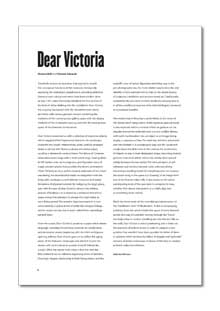 |
|||||||||
|
|
| ...Publications: Annual | ...The Physics Room Annual 2004 | |||||||||||||
|
Dear Victoria. Twentieth-century art practices that aspired to unpick the conceptual functions of the museum, strategically exploring the institution’s stated role in providing definitive historical and cultural overviews, have been evident since at least 1941, when Duchamp exhibited the first version of his Boite en Valise. Walking into the installation Dear Victoria, the ongoing fascination with the Wunderkammer seems pertinent, with various gestures toward combining the starkness of the contemporary gallery space with the display methods of the nineteenth century, and with the more private space of the domestic environment. Dear Victoria presented us with a selection of imprecise objects which suggested the fragmented elements of a landscape, clustered into cryptic relationships, some carefully arranged inside a cabinet with fluted, sculpted, decorative edges, recalling a nineteenth-century frame. The failure of Cartesian rationalism looms large with a moth-eaten stag’s head, grafted in DIY fashion onto an incongruous, anti-figurative torso of rough wooden planks that provides the show’s centrepiece (‘Deer’Victoria, no less), and its clearest statement of the cloud wandering, the disembodied head’s re-integration with the body, with contingency, and with the temporal and spatial limitations of physical materials. By realigning the stag’s glassy eyes with the eyes of Dear Victoria’s viewers, the reifying process of looking is re-activated as a relational and ethical space, a loop that attempts to salvage the stag’s status as once-living animal. The wooden stag-mannequin is in turn surrounded by a sparse forest of antler-like designer foliage, neither wood nor tree, but instead crafted from camouflage printed fabric. From the outset, Dear Victoria is posed as a space which denies language, including the personal pronoun, its classificatory and denotative power, beginning with the title’s ambiguous opening address. Dear Victoria goes on to collect the aging props of the Romantic landscape, into which it inserts the viewer, with an invitation to wander around “behind the scenes”. What the viewer finds there is that the view has little behind it but an infinitely regressing series of sketches. Drawing’s integral relationship to both Romanticism and the scientific view of nature (figurative sketching was, in the pre-photographic era, the most reliable way to describe and identify) is here overlaid with its links to the recent history of sculpture, installation and process-based art. Traditionally considered the precursor to other mediums, drawing here is, in all the unselfconsciousness of its methodologies, harnessed as conceptual baseline. The relationship of drawing to authenticity (in the sense of the “artists hand” being author of the signature gestural mark) is also explored within a context where no gesture can be singular; instead the authorial voice is a near-audible debate, with each manifestation into an object or an image being, largely, a consensus of two. The mark has not been automated and mechanised in a conceptualist way, but left casual and rough, hence the little trees in the cabinet, the restlessness of objects to stay in their designated shape, becoming instead gestures that recur within and across media, ideas passed visibly between the two artists. The intricate layers of self reference and mimicry become cyclic, with everything becoming a working model for everything else. For instance, the noose hung in the space is a “drawing” of an image from one of the blurred video stills. It also draws on the active participating body of the spectator to complete its loop, whether that viewer interprets it as a child’s play item or something more sinister. Much has been made of the essential spectatorlessness of the “installation shot” of Modernism. In the accompanying publicity shots the artists inhabit the space, Victoria Edwards astride the stag, Victoria Bell moving through the “forest”, her body a blur in motion (recalling also the blurred stills on the wall).Dear Victoria is about positioning, and it draws on the practices of both its artists in order to catalyse a new position that wouldn’t have been possible for either of them in isolation, which declares the failure of singular and “authentic” versions of artistic endeavour, in favour of the idea of creation as fertile collective influence. Sally Ann McIntyre View Dear Victoria. Essay by Sally Ann McIntyre as a PDF This essay originally appeared in The Physics Room Annual 2004 Order your copy today from The Physics Room ! Related 6 April - 1 May, 2004
|
|||||||||||||


